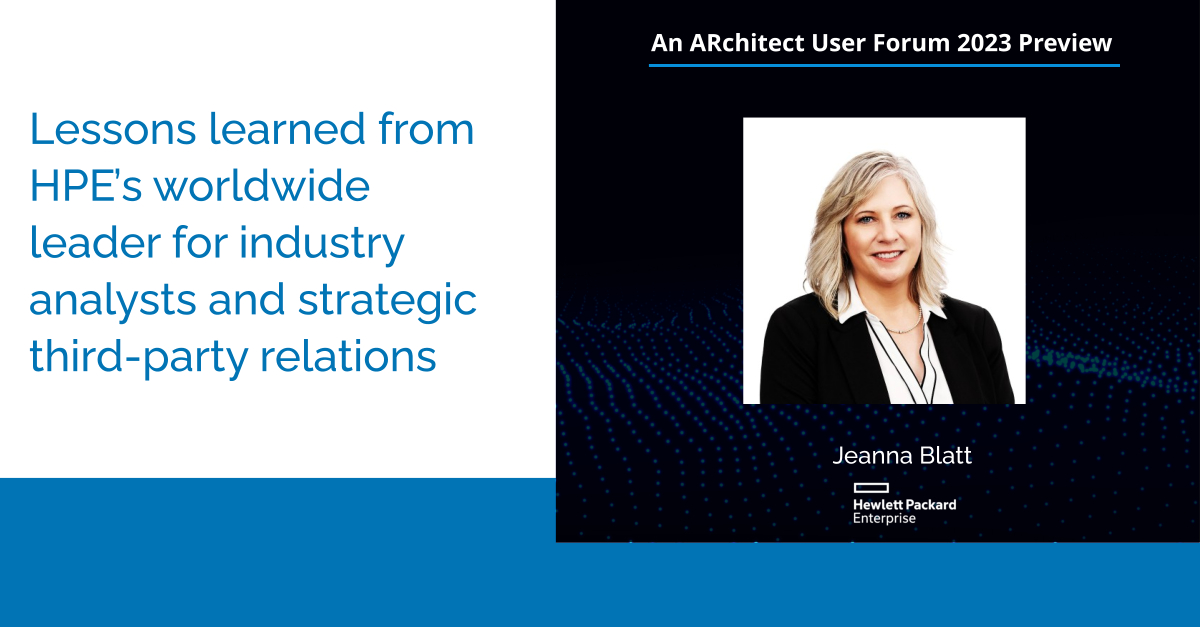How can analyst relations (AR) teams build better “connective tissue” with other functions — and why is it strategic to do so? Karsten Scherer is an expert on the topic, with thought-provoking advice and diverse experiences from an accomplished career.
Needless to say, we were thrilled to speak with Karsten, co-founder of strategic communications and influencer relations consultancy Forge & Refine, for our latest Profile in AR. Karsten’s deep AR knowledge — gleaned from both in-house AR positions, as well as consulting work — and his expertise in business strategy and transformation provided fodder for a terrific conversation: on the nature of strategic AR, synergies and dependencies with other functions, and a lot more. Karsten is also an advocate for mental health awareness in the workplace and shared strategies for prioritizing mental health within organizational culture.
With so many useful insights, this interview couldn’t be contained in one article! Don’t miss Part II, covering Karsten’s advice for strengthening AR programs, the melding of analyst and influencer relations, and more, which will publish next week. And without further ado, here’s the first part of the interview:
Q: How did you get into analyst relations?
Karsten: Like pretty much everybody else, I slid into AR from elsewhere. I actually went to college intending on getting an acting degree and was dead set on making a living in theater. But the best laid plans of mice and AR… it was inevitable my career took a couple turns. I ended up with a poly sci degree, and my first gig out of college was in organizational development. I worked at Siemens in Germany; I’m half German and spoke the language. I lucked into a Gartner seat right out of the gate and didn’t know anything about AR at that point. Still, I was fascinated by what the analysts we worked with did for a living.
Then from Siemens, I went to a McKinsey incubator, also in Germany. In that role, I had analyst access and leveraged research and advisory services a lot — tapping into the analysts’ expertise and continuing to find their role really cool.
Fast forward a couple years: I took a strategy position with a small vendor in the telecom space. Their AR guy had just left, and the company asked me if I could pick up that role too. My answer basically was: “I have no idea. But why not give it a shot?” That’s when I started understanding: Okay, there’s this craft called AR — and it stands for analyst relations, not accounts receivable. Plus, it looks like a lot of fun.
Since then, throughout my career, I’ve never joined a company with an existing AR program. I’ve always started them from scratch — identifying the first brick, putting it on top of the second, and at some point, making an edifice of some sort.
At first, I didn’t have anyone to learn from, so I ended up leaning heavily on AR people at other companies. That’s one of the reasons I love the AR community so much. There were a lot of people who invested time in me, the “new kid” who didn’t know what he was doing, and I was very grateful.
I worked in AR roles at multiple companies through 2018. Soon after, I co-founded Forge & Refine with my wife Laura.
Q: Tell us about Forge & Refine. What types of companies do you work with, and what sets you apart?
Karsten: We’re a small consultancy. We chose the name because sometimes our clients need to build something new, and sometimes they want to re-envision something already in place. Laura is a former Gartner analyst, where she focused on financial services and ecommerce. She’s a brilliant thinker and a brilliant writer, and helps clients with strategic communications and ghostwriting. She worked with the authors on Gartner’s 2019 book on blockchain, for example. I bring some skills to the table around organizational development, program development, innovation, strategy and change management.
Our clients run the gamut: the tech providers large and small you’d expect, as well as venture capital firms and international development organizations, such as the World Bank. For some of these clients, our engagements don’t focus on AR; they focus on strategy and strategic content. And while some of our clients lead AR programs, increasingly, many lead sales or strategy functions. Frequently, they’re looking to us to help them better partner with AR and build a more strategic and collaborative relationship. That’s provided an interesting, outside-in view on how AR is frequently perceived or misunderstood and therefore under-partnered with by other functions.
In terms of the AR services we provide: We know every AR program has a lot on its plate, and we decided early on not to cover all of that. There are niches we’re really good at and that we lean into — so we focus on inbound insights and strategic program development, especially in the context of the value exchange between AR and other functions.
Companies spend a lot of money on research firms and often only get tactical value of what should be a strategic investment. We help companies and their AR teams extract meaningful, strategic value from the smart, expensive experts at these firms. And then we help our clients build internal relationships of trust and value, where they can contextualize analyst insights for their organizations.
We also invest a significant amount of time upfront to understand each client’s organization as a whole. Using AR as an example: We look not just at AR, but also at its partner functions, as well as the organization itself — its culture, markets, strategy, the whole shebang. We focus on elevating the stakeholders we work with — whether they sit in sales enablement, innovation, AR, R&D, etc. — within the overall ecosystem of their company and embed ourselves as an extension of their team.
Q: What are some common AR mistakes you’ve seen?
Karsten: Nothing operates in a vacuum. AR certainly doesn’t, so as a function, we shouldn’t act that way.
So, it’s important to know: Does AR have a bead on what makes sales enablement or product marketing look great at the end of the budget cycle? If you’re an AR pro and don’t know this, then make it a priority to find out, build a campaign around it, and do so at a regular cadence. Ideally, at some point, it becomes part of your functional DNA: “This is how we do AR around here.”
Admittedly, it can be scary to ask other functions, “What makes a good year for you?” because it might open up a can of worms and activities that AR may not have the bandwidth to handle. But avoiding the question doesn’t help us be strategic; it helps us hide. So that’s the first thing — don’t pretend like you’re in a vacuum.
Secondly, as a craft, we generally do a really good job of putting our company’s best foot forward: with “these are our services,” “this is why our widget is better than the other guys’” and other AR bread-and-butter outbound. But I would not give us the same score for how we tend to define and market our own value internally.
That brings me to another point: You can’t hit a target you haven’t defined. If an AR function doesn’t put the legwork and brainwork into defining metrics and targets that matter, you have nothing to hang your internal value message on. That leads to the activity-versus-outcomes conversation: You might have had a 500% increase in briefings, but what did those conversations actually do? If you’re defaulting to only measuring activity, you can’t be strategic.
Finally, AR programs can sometimes become an “ivory tower” exercise. Maybe you’re a sole practitioner or on a small team that’s directly aligned to the CMO — you know you need to make that level of the organization happy. And that makes sense; it’s human nature to behave in ways to avoid getting penalized or, ideally, to get rewarded.
But it’s important to expand your interactions internally because a lot of interesting things happen at the edge. You can learn: How are clients reacting to your solutions? What types of sales pitches aren’t landing? And so on.
So, isolating one’s program doesn’t serve anyone well. If you’re in AR and have 20 or 30 extra minutes, go help someone in sales. I’ve seen AR actively shy away from taking calls from salespeople who want to know, “How can we leverage the smart things you’re doing and learning in AR in ways that help me sell better?” Of course, scale and staffing always become an issue, but I passionately believe in not isolating ourselves. Don’t make PowerPoints for a living; make progress.
Q: Where do you see the future of AR headed?
Karsten: As with many business areas today, large language models (LLMs) and generative AI will have an impact. In working with research firms, I know they’re looking at how to leverage generative AI in content creation, as a research tool and as a way to provide quick answers to common inquiries — training models on frequent analyst responses.
Similarly, we’ll see applications for generative AI in AR. I’m lucky to be part of a couple of groups that are noodling on what this future looks like. So, for example, if you’re part of a large AR team that’s been cataloging all your briefing and inquiry notes, in the future, you might ask generative AI something like: “Do a sentiment analysis on everything IDC has told our 15 business units about strategy. Provide a draft report to these specs.”
Or a newly hired AR person at a company could ask GenAI: “Who are my business unit’s main analysts? What are they like based on tonality and how they interact with our organization?” Here’s another example: “Dear GenAI, it’s time for our monthly AR report to stakeholders. Please pull out anything interesting along these specs, and put it in a PowerPoint that looks cool and helps me tell a good story.”
Those are all things that aren’t far away. And they bring up that age-old question about automation, across business sectors: “Are jobs going away?” Most won’t — they’ll change, and in AR, automation can and will free up professionals to do more inbound activities. AR functions always struggle with scale and strategic value, and technology will provide a shortcut, so AR pros can focus more on strategy.
I also think the strategic leveraging of technology for AR works part and parcel with where I see analyst relations bifurcating into strategic AR and AR operations/execution. And at some point, I think you can make a case for AR ops being run from anywhere. Work is work — whether it’s done in-house, by an agency or consultant, whether it’s tech-enabled or not — and it’s got to get done. I don’t think it even always needs to get done by AR.
Strategic AR looks at: “Is AR aligned with other functions?” “How is it helping them?” “Does AR have a bead on what organizational success looks like?” After building up all of this connective tissue, AR has a real opportunity to differentiate itself within the company and differentiate the company as a player in its market.
In my work, I get asked a lot by innovation, sales and marketing departments how to better partner with AR. That’s an indicator that there are still vast gaps and opportunities to build better connections. AR and these other functions don’t form a Venn diagram yet; they’re a bunch of circles that sometimes overlap. As we move forward, there will be greater emphasis on how AR can expand the edges of what it can influence.
Q: Apart from AR, you’re an advocate for mental health awareness in the workplace. Can you tell us more about the work you do there – and where companies should be focusing efforts?
Karsten: I come by my interest in mental health advocacy honestly, having struggled myself and white-knuckled my way through periods in life — both as a kid and in adulthood, to the point where I even had to leave work, full-stop. Hiding how I was feeling cost me a lot of energy, and it made me realize I want to be transparent about where I’m at.
Being open about my experience has unlocked a lot of really interesting conversations. In the end, it seems like everybody is dealing with something — or knows someone who’s struggling — and we tend to shy away from talking about it collectively because there’s a lot of shame involved. But it’s important to remove that shame and stigma.
I volunteer with the National Alliance on Mental Illness (NAMI), the U.S.’ largest grassroots mental health organization, and am on the board of my regional chapter. In addition to helping with NAMI’s strategy work, I spend a lot of time on behalf of NAMI talking to different groups at high schools and colleges, correctional facilities, psychiatric units and more, helping to destigmatize mental health discussions and drive awareness.
I also spend a lot of time talking about mental health in corporations, and I’ve seen that the way organizations articulate things around mental health is a bit behind where it should be. I’m often invited to talk not by HR — but by functional leaders who have had someone struggle on their teams. For example, I spoke with a group recently at a Fortune 100 manufacturer where there was a suicide on the sales team. They reached out to us saying, “Can somebody come and talk with us about their experiences and help us make sense of this?”
Frequently, the functional leaders will also say, “Don’t let HR know we’re doing this.”
So, I think HR has some work to do as a craft. Their job is to protect the organization. There’s always policy, but when policy gets outdated, changes tend to fall on individual leaders — based on how much they understand and how far they’re willing to lean in.
And even when department leaders may not have personal experience with suicidal ideation, they can sympathize and provide support if they’re educated about the topic and about neurodiversity strategies. To that end, HR should help define: “What’s the education talk track around mental health for leaders?” “What’s the talk track around mental health for employees?” Ideally, there will be internal support functions at the organization — and if not, there should be the ability to point to external support functions. Every company has a culture, and supporting mental health can and should become a cultural thing. What’s more, if there isn’t a culture of trust, employees often hide how much they’re struggling for fear it will affect their career viability. That’s all to say that education is incredibly important.
***
Many thanks to Karsten for sharing his insights, advice and experiences. If you’d like to connect with Karsten, you can reach him on LinkedIn. And don’t miss Part II of our interview, which will be published next week.




